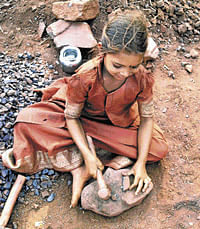Boost in rural employment and literacy to reduce child labour

Essentially, child labour is the product of poverty stemming primarily from illiteracy. Lack of education contributes to large families especially in the rural areas in the belief of turning children into bread winners. Presence of a high degree of unemployment, both in the rural as well as urban areas, compounds this, diverting children from schools to work places.
Unfortunately, children being available to work at half or even quarter of the wages paid to an adult further increases demand for child labourers. This is especially so in the hospitality segment, carpet weaving industry, matches, agarbathi and beedi industry, fire crackers to name a few.
It is thus not uncommon to find small boys working as cleaners in Dhabas and small restaurants. Similarly, industries like beedi making, match sticks, agarbathi factories look for nimble fingers charging low wages. Children are found working here under bad lighting conditions, long hours for paltry sums.
Though legislations prohibit hiring of children, many of these cottage industries succeed in hiring them without detection. To check this, the government has come out with schemes like the National Rural Employment Guarantee Scheme (NREGS). Under this scheme, rural unemployment is tackled by guaranteeing wage employment of 100 days of work in a financial year for every rural household having an adult willing to do unskilled work.
Besides providing a means of livelihood for at least three months in a year, the NREGS serves to check migration of labour from the rural to urban areas. During the year 2007-08, the scheme provided employment to 3.39 crore households generating 143.5 crore person days in 330 districts. In the subsequent year, 2008-09, this increased to 253 crore households though the actual person days generated amounted to only 85.29 crores. This significantly increased the wage earnings of the rural households during this period. Incidentally, over 68 per cent of the funds in the scheme was utilised to pay wages during 2007-08 while the same amounted to 73 per cent in 2008-09.
Designed to be self targeting in nature, the programme has high reach participation amongst the marginalised sections like SC/ST and women—about 57 per cent, and 43 per cent respectively during the year 2007-08 and 54 per cent and 49 per cent respectively for the year 2008-09. An important aspect of NREGS is the nature of employment structured to strengthen the natural resource base of the rural areas. For instance, in 2007-08, out of the 17.88 lakh works undertaken, 49 per cent related to water conservation. The same was 16.88 lakh works and 49 per cent respectively during 2008-09. Since water is a major resource required by a rural household for agriculture, adopting strong measures to ensure its conservation and better supply can go a long way in improving the conditions of a rural area. To promote banking and in turn savings, the wage payments here are made largely through bank and post office accounts of the wage seekers. Thus, about 2.9 crore NREGA bank and post office accounts were opened up to July 2008. Encouragement has also been given for workers to obtain insurance under the Jan Shri Bima Yojana. The NREGS has also floated the Sarva Shiksha Abiyan (SSA) which aims to universalise elementary education through community ownership of the school. Essentially a response to the demand for quality basic education in the country, the SSA attempts to provide this community owned quality education on the lines of missionary educational institutions.
Unfortunately, though the NREGS has had a significant presence, it has not been effective in stemming the increasing number of child labourers, especially from rural areas. It is hence imperative to look beyond NREGS to make a sizeable impact. For instance, increasing employment opportunities through various self-help schemes and tapping non-conventional energy can serve as a major income generating source for the household as well as the village.
The government also needs to take concrete steps to provide basic standard of living in the rural areas in terms of health and hygiene. This translates as guaranteed supply of water and electricity, easy access to good health facilities. This can go a long way in upgrading the quality of life and indirectly have an effect on the extent of child labour.
While the government has indeed set up free schools in rural areas, the quality of education imparted here is suspect. It is important to revamp the quality of these schools besides making education compulsory. Making education compulsory through legislation and punishable in its absence can go a long way in reducing as well as eliminating child labour in the long run. To increase the reach of education, the schools should also become adult literacy centres in the evenings.
The system of education, especially that addressing rural segments indeed requires rethinking. For instance, the present system permits a child to opt for vocational training after grade 10.
If a child is not academically oriented, imparting vocational training along with elementary education from the 6th grade onwards can prove more practical. Such a facility not only provides the child with literacy but also a job-oriented course to ensure employment on completion of education.
(The writer is Head Regulatory, TeamLease Services)
Deccan Herald is on WhatsApp Channels| Join now for Breaking News & Editor's Picks